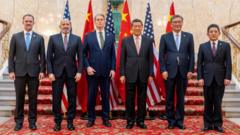Top trade officials from the US and China concluded two days of discussions in London, agreeing on a framework aimed at reducing trade tensions, particularly regarding rare earth minerals, with the plan now set to be reviewed by President Trump and President Xi.
US and China Reach Framework on Trade Talks Ahead of Presidential Approval

US and China Reach Framework on Trade Talks Ahead of Presidential Approval
US and China negotiate a de-escalation plan for trade tariffs, pending approval from Trump and Xi.
The article text:
Top officials from the United States and China have wrapped up negotiations in London, announcing a preliminary agreement aimed at easing the trade tensions that have long plagued their economic relations. US Commerce Secretary Howard Lutnick revealed that both sides have made progress toward resolving issues related to rare earth minerals and magnets, crucial components in modern technology production.
This newly proposed framework will be taken to Presidents Donald Trump and Xi Jinping for final approval, as both nations seek a solution to ongoing disputes amplified by tariffs. The discussions followed a temporary truce on trade tariffs agreed upon last month, which has been tested by mutual accusations of violations.
The focus during the London meetings largely revolved around the export of rare earth minerals from China, which play a vital role in the manufacturing of devices ranging from smartphones to electric vehicles. The US has previously criticized China for its slow release of these key components, while also imposing restrictions on Chinese access to important goods, like semiconductors.
Lutnick expressed confidence regarding the new framework, emphasizing the necessity of presidential endorsement for further implementation, stating, "Once the presidents approve it, we will then seek to implement it." The plan's genesis can be traced back to a recent phone call between the two leaders, which Trump described as a "very good talk."
During previous negotiations in Switzerland, a truce achieved a temporary reduction of tariffs, with the US cutting its rates on Chinese goods down to 30%, while China reciprocated with a decrease to 10% on US imports and committed to lifting barriers on key mineral exports. However, each side has since accused the other of failing to adhere to non-tariff conditions of the agreement.
The US Trade Representative, Jamieson Greer, noted China’s slow rollback of restrictions on rare earth magnets, while Beijing highlighted various US actions as violations, such as halting sales of essential computer chip design software to Chinese firms.
In a response to the current negotiations, the Chinese Ministry of Commerce indicated its approval of certain export licenses for rare earth materials, although specifics on recipient countries were not disclosed. Prior to this week’s discussions, Trump stated that Xi had agreed to revive trade in rare earth materials, signaling a possible path towards a renewed collaborative spirit in US-China trade relations.
Top officials from the United States and China have wrapped up negotiations in London, announcing a preliminary agreement aimed at easing the trade tensions that have long plagued their economic relations. US Commerce Secretary Howard Lutnick revealed that both sides have made progress toward resolving issues related to rare earth minerals and magnets, crucial components in modern technology production.
This newly proposed framework will be taken to Presidents Donald Trump and Xi Jinping for final approval, as both nations seek a solution to ongoing disputes amplified by tariffs. The discussions followed a temporary truce on trade tariffs agreed upon last month, which has been tested by mutual accusations of violations.
The focus during the London meetings largely revolved around the export of rare earth minerals from China, which play a vital role in the manufacturing of devices ranging from smartphones to electric vehicles. The US has previously criticized China for its slow release of these key components, while also imposing restrictions on Chinese access to important goods, like semiconductors.
Lutnick expressed confidence regarding the new framework, emphasizing the necessity of presidential endorsement for further implementation, stating, "Once the presidents approve it, we will then seek to implement it." The plan's genesis can be traced back to a recent phone call between the two leaders, which Trump described as a "very good talk."
During previous negotiations in Switzerland, a truce achieved a temporary reduction of tariffs, with the US cutting its rates on Chinese goods down to 30%, while China reciprocated with a decrease to 10% on US imports and committed to lifting barriers on key mineral exports. However, each side has since accused the other of failing to adhere to non-tariff conditions of the agreement.
The US Trade Representative, Jamieson Greer, noted China’s slow rollback of restrictions on rare earth magnets, while Beijing highlighted various US actions as violations, such as halting sales of essential computer chip design software to Chinese firms.
In a response to the current negotiations, the Chinese Ministry of Commerce indicated its approval of certain export licenses for rare earth materials, although specifics on recipient countries were not disclosed. Prior to this week’s discussions, Trump stated that Xi had agreed to revive trade in rare earth materials, signaling a possible path towards a renewed collaborative spirit in US-China trade relations.




















